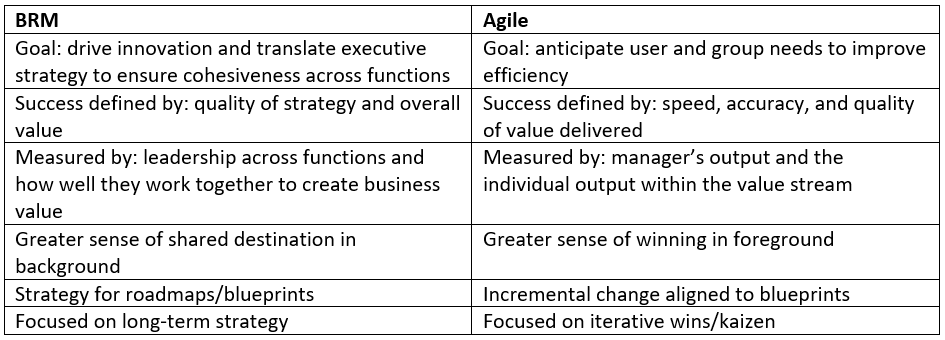Agile vs. BRM: What’s the Difference?

Increasingly, BRMs encounter terminology related to Lean-Agile, and many often confuse business relationship management (BRM) strategies with Agile strategies. The two share enough similarities to cause confusion on which to use, if not both. While each methodology provides its own benefits, using both BRM and Agile together will bring the most success. It’s important to understand the benefits of using both, while properly defining them and explaining the differences.
BRM and Agile serve very different purposes, but with the same goal in mind: optimizing business value. Since they utilize differing strategies to achieve that goal, the analogy of sailing a ship helps explain the differences. On the ship, a crew works towards the common goal of arriving quickly to their destination; the captain and key decision-makers use a compass to chart their course while the sailors rapidly adjust the sails to follow that course.
In this analogy, BRM is like the compass, responsible for determining the long-term direction of the organization to ensure value is optimized and the ship arrives at port. Agile strategies are like the sails, responsible for making quick course adjustments to generate value. Both instruments function well enough separately but using them together greatly amplifies their effectiveness. Here, the two terms are defined:
BRM
Stated simply, BRM delivers business value through translating executive leadership strategy into a shared roadmap. A BRM capability proves effective when it drives value at the highest level of business functions. This leads to accomplishing the focus of BRM, which is breaking down siloes and ensuring shared ownership of both strategy and ensuring results across the organization
Agile
By contrast, Lean-Agile succeeds through translating business strategy into delivered value. Unlike many previous development models, Agile takes an iterative hands-on approach to value creation. Agile focuses on generating numerous small wins which leads to a culture of continuous improvement at the team level.
Further than definitions, the table below lists the main differences between BRM and Agile to provide an in-depth distinction.

BRM will set the long-term strategy, but the organization will progress slowly without the continuous improvement mentality of Agile. Likewise, an organization can move swiftly and effectively with Agile. But it may move swiftly in the wrong direction without BRM to establish a road map. Your organization will achieve optimal business value by jointly adopting BRM and Agile capabilities. The BRM team ensures strategy for the organization, while Agile teams efficiently execute on that vision, rapidly responding to change as needed.
Successful organizations thrive on rapid evolution, executing on shared vision, and moving all the individuals in unison. Using both BRM and Agile capabilities empowers your organization to accomplish all these success factors. While these two methodologies alone do not create a successful organization, they use complementary to establish a strong foundation. So, with this in mind, what’s the next step for your organization?
Business Relationship Management Institute’s White Paper on the topic outlines how to introduce and coordinate BRM and Agile in your organization.

Aaron,
This is such a simple concept, but so many people refuse to see beyond what they know and have been doing for years.
Unfortunately I lost the battle at CuraScript SD. We had an agile coach and new director that refused to see the value of BRM in and Agile environment. I fought it as long as I could but the BRM role was eliminated and so I have moved on.
Bob,
I’m sorry to hear this; many in the Agile community don’t understand (or mis-classify) the BRM role as a BA or a duplicate of a Product Owner. That’s not a knock on Agile or the community (I’m a multi-certified, practicing member of that community), it’s just the reality of where the community understanding is with Business Relationship Management. We are working hard to modify and improve that understanding!
The specific differencebetween a BRM and the Product Owner is that the Product Owner should be focused on the team or teams they work with delivering value while the BRM works much earlier in the process to help organize and define Strategic Value in preparation for moving work through to the teams who will decompose the work and deliver the value. Overall, BRMs and Agile teams/roles are complimentary not in competition!
Good luck in your new role!
Aaron